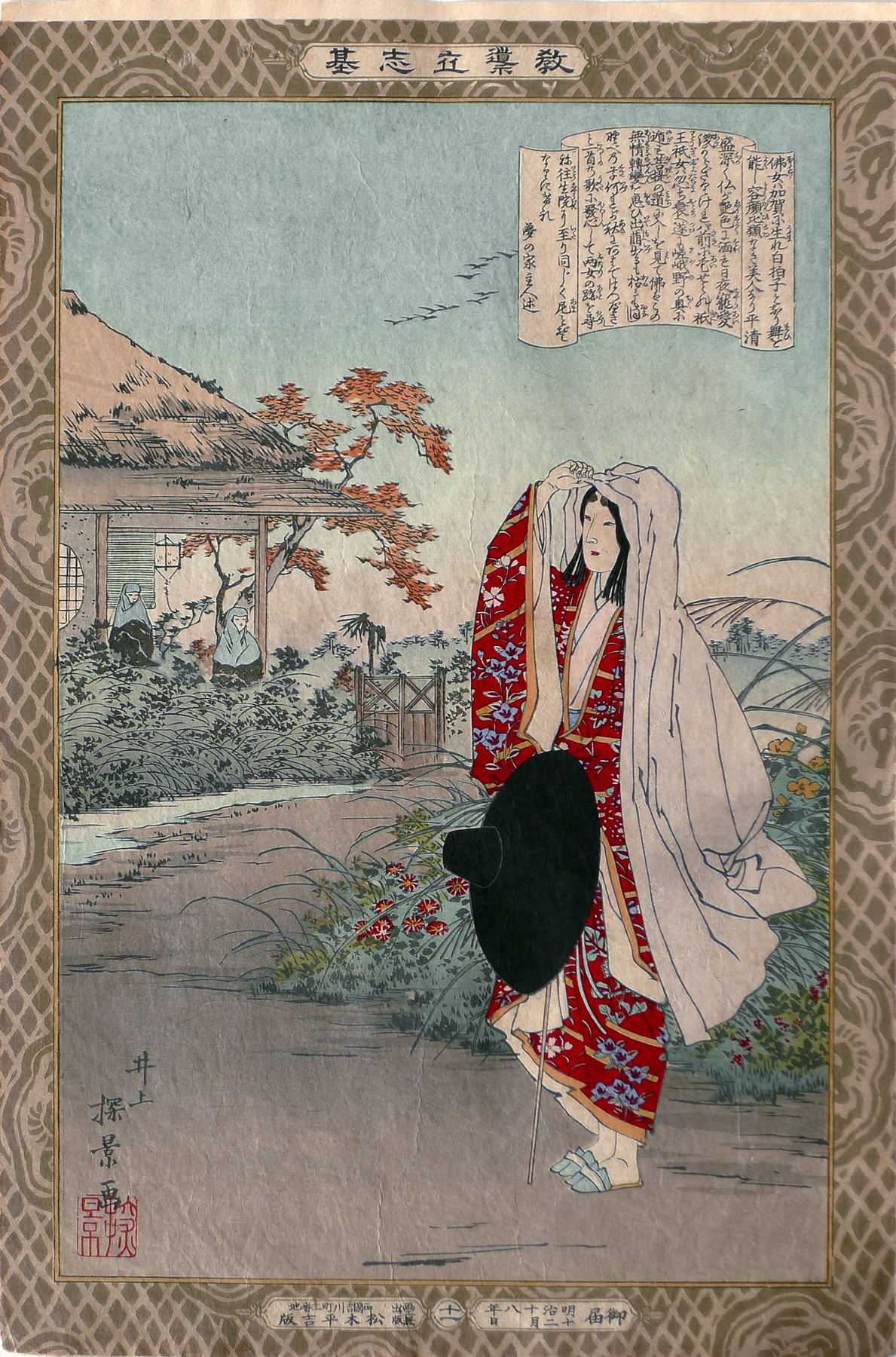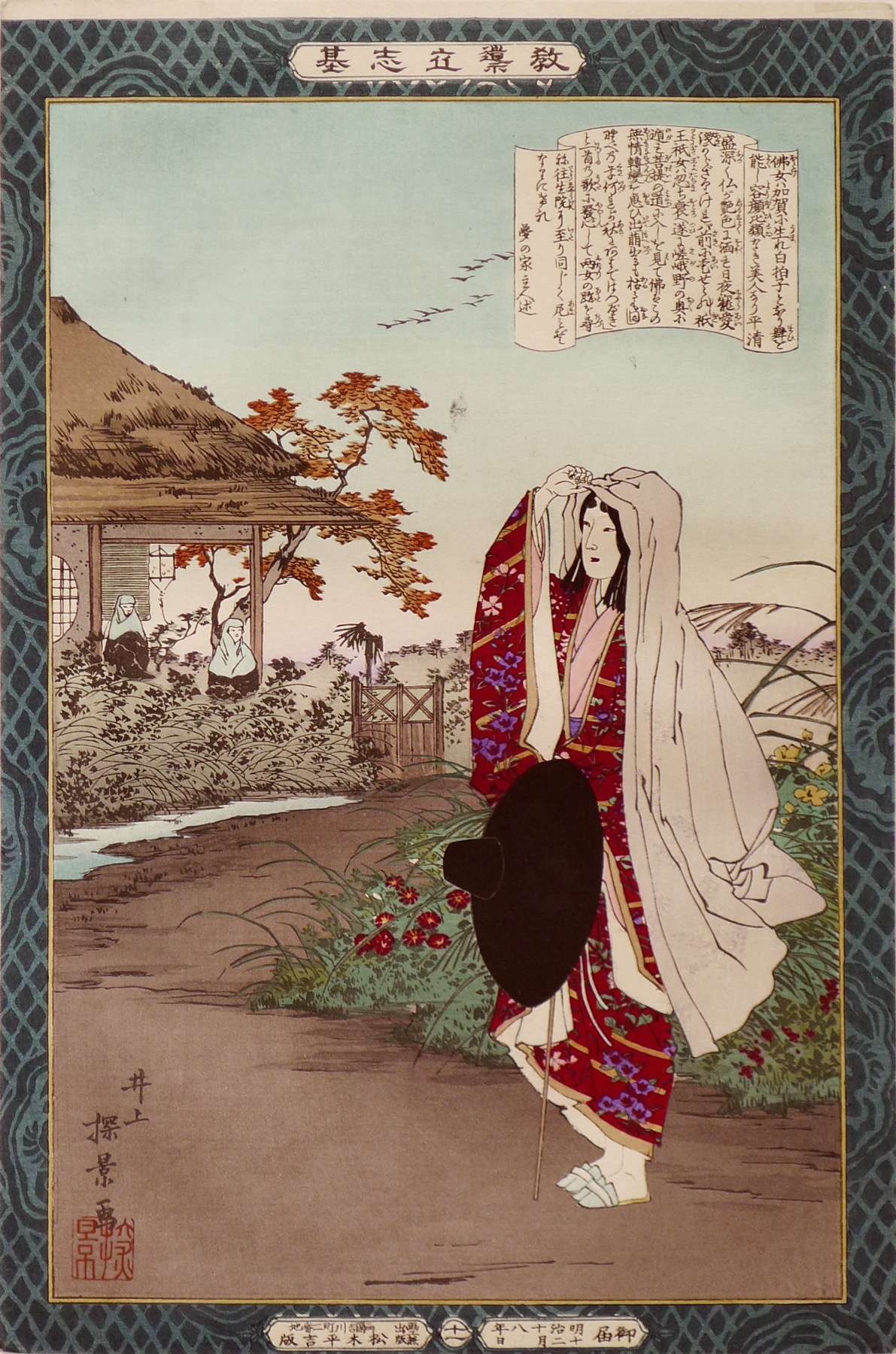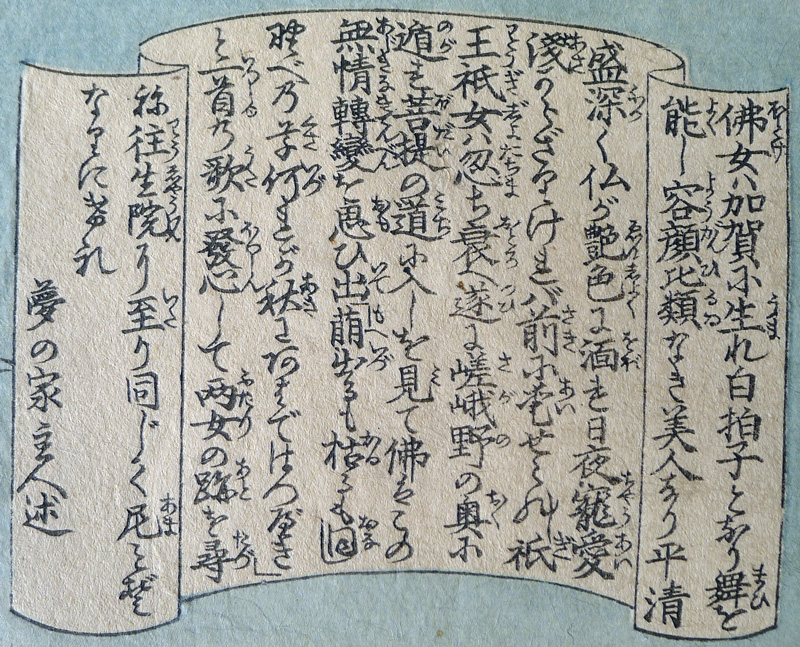About This Print
Print number 十一 (11)1 in the series Instructive Models of Lofty Ambition picturing the court dancer Hotoke Gozen 佛御前 arriving at a mountain hut to take refuge and become a nun.As with many, if not all, of the prints in the series, it was printed with at least two different colored brocade borders. As shown, the colors used for the print itself were slightly modified for the two printings. It is unknown which of the two prints is an earlier printing.
Inoue, a student of Kobayashi Kiyochika, contributed thirteen prints to this series. He was to die at the age of 25 in 1889, the year this print was issued.
The Story of Hotoke Gozen
Hotoke Gozen, consort of Taira no Kiyomori 平清盛 (1118-1181) and a shirabyōshi 白拍子 (traditional court dancer), arrives at an isolated mountain hut made of brushwood in Sagano, built by Taira’s former consort, the court dancer Gio. It is occupied by Gio, her mother and younger sister who have become nuns after Gio’s expulsion by Taira from the palace to make way for Hotoke. Hotoke has come to ask Gio’s forgiveness and permission to join her as a nun. The Heiki Monogatari relates that they all “attained their desire for rebirth in Paradise.” The story is told in The Tale of the Heike (平家物語 Heike Monogatari), an epic account of the struggle between the Taira and Minamoto clans for control of Japan at the end of the 12th century in the Genpei War (1180-1185).
Transcription of Scroll
click on scroll to enlarge
Source: with thanks to Yajifun http://yajifun.tumblr.com/11 Hotoke Gozen 佛御前
教導立志基 十一 佛御前 井上探景(安治) 1885年12月
Transcription: [scroll text by 夢の屋主人]
“仏女ハ加賀に生れ白拍子となり舞を能(よく)し容顔比類なき美人なり。平清盛、深く仏が艶色に湎(をぼ)れ日夜寵愛浅からざりけれバ前に◯(あい)せられし祇王祇女ハ忽ち衰ヘ遂に嵯峨野の奥に遁れ菩提の道に入しを見て仏はこの無情転変を思ひ出「萌出るも枯るも同じのべの草 何れか秋にあはで果つべき」と一首の歌に発心して両女(ふたり)の跡を尋ね往生院に至り同じく尼にぞなりにけれ 夢の家主人述”
Jim Dwinger, in his incisive article on this series appearing in the journal Andon, identifies the writer of this scroll as the news reporter Fukuichi Gen'ichirō, writing under the pseudonym Yume no Ya Shujin, who himself was subject of a print in this series by Kobayashi Kiyochika (1847-1915) titled, Fukuchi Gen’ichirō.3
About The Series "Kyōdō risshi no motoi"
Notes:1. This series is variously translated as "Instructive Models of Lofty Ambition," "Foundations of Learning and Achievement," "Foundation of Instruction and Perseverance," "Self-Made Men Worthy of Emulation," "Paragons of Instruction and Success," "Moral of Success," "Examples of Self-Made Leaders," and "Instruction in the Fundamentals of Success." The title in Japanese is sometimes seen as "Kyōdō risshiki or "Kyōdō risshi no moto," in addition to the most commonly seen transliteration of "Kyōdō risshi no motoi".2. For a complete listing of all the prints in the series and additional information please see the article on this site titled Instructive Models of Lofty Ambition.
This series ran between October 1885 and November 1890 and featured a long list of heroes and heroines, from antiquity to contemporary times, who were regarded as standards of moral leadership and self-realization.
Source: Kiyochika Artist of Meiji Japan, Henry D. Smith II, Santa Barbara Museum of Art, 1988, p. 74-75; original research and as footnoted.
This series of 58 prints,1 plus a table of contents sheet (目録), were originally published between October 1885 and November 1890 by the Tokyo publisher Matsuki Heikichi 松木平吉.2 The table of contents sheet issued by the publisher states that "fifty prints make up the complete set (五十番揃)". Three prints not in the initial release were added over the five year publication period, as were five redesigns of original prints, eventually increasing the total print count to 58. The seven artists contributing prints were Kobayashi Kiyochika (1847-1915) [20 prints], Mizuno Toshikata (1866-1908) [16 prints], Inoue Tankei (Yasuji) (1864-1889) [13 prints], Taiso (Tsukioka) Yoshitoshi (1839-1892) [5 prints], Yōshū Chikanobu (1838-1912) [2 prints], Toyohara Kunichika (1835–1900) [1 print], and Hachisuka (Utagawa) Kuniaki II (1835-1888) [1 print]. All the artists, with the exception of Yōshū Chikanobu, are listed in the top scroll of the table of contents sheet. Various colors (including blue, blue/green, and tan/brown) were used for the decorative border, and in 1902 the series was re-issued by Matsuki without borders.
Brief texts contained within a scroll-like cartouche appearing on each print provide historical details. The scroll composer's name is given at the end of the scroll text. The “lofty ambition” of the title is a Confucian concept, originally from Mencius, meaning “righteous determination that would inspire others.” The market for the series probably included former samurai, ambitious youth, and conservative intellectuals.
"[W]hen it was completed in 1890 the publisher was singled out for special recognition by the government for having sponsored such noble subject matter."4
This series ran between October 1885 and November 1890 and featured a long list of heroes and heroines, from antiquity to contemporary times, who were regarded as standards of moral leadership and self-realization.
Source: Kiyochika Artist of Meiji Japan, Henry D. Smith II, Santa Barbara Museum of Art, 1988, p. 74-75; original research and as footnoted.
This series of 58 prints,1 plus a table of contents sheet (目録), were originally published between October 1885 and November 1890 by the Tokyo publisher Matsuki Heikichi 松木平吉.2 The table of contents sheet issued by the publisher states that "fifty prints make up the complete set (五十番揃)". Three prints not in the initial release were added over the five year publication period, as were five redesigns of original prints, eventually increasing the total print count to 58. The seven artists contributing prints were Kobayashi Kiyochika (1847-1915) [20 prints], Mizuno Toshikata (1866-1908) [16 prints], Inoue Tankei (Yasuji) (1864-1889) [13 prints], Taiso (Tsukioka) Yoshitoshi (1839-1892) [5 prints], Yōshū Chikanobu (1838-1912) [2 prints], Toyohara Kunichika (1835–1900) [1 print], and Hachisuka (Utagawa) Kuniaki II (1835-1888) [1 print]. All the artists, with the exception of Yōshū Chikanobu, are listed in the top scroll of the table of contents sheet. Various colors (including blue, blue/green, and tan/brown) were used for the decorative border, and in 1902 the series was re-issued by Matsuki without borders.
This series of 58 prints,1 plus a table of contents sheet (目録), were originally published between October 1885 and November 1890 by the Tokyo publisher Matsuki Heikichi 松木平吉.2 The table of contents sheet issued by the publisher states that "fifty prints make up the complete set (五十番揃)". Three prints not in the initial release were added over the five year publication period, as were five redesigns of original prints, eventually increasing the total print count to 58. The seven artists contributing prints were Kobayashi Kiyochika (1847-1915) [20 prints], Mizuno Toshikata (1866-1908) [16 prints], Inoue Tankei (Yasuji) (1864-1889) [13 prints], Taiso (Tsukioka) Yoshitoshi (1839-1892) [5 prints], Yōshū Chikanobu (1838-1912) [2 prints], Toyohara Kunichika (1835–1900) [1 print], and Hachisuka (Utagawa) Kuniaki II (1835-1888) [1 print]. All the artists, with the exception of Yōshū Chikanobu, are listed in the top scroll of the table of contents sheet. Various colors (including blue, blue/green, and tan/brown) were used for the decorative border, and in 1902 the series was re-issued by Matsuki without borders.
Brief texts contained within a scroll-like cartouche appearing on each print provide historical details. The scroll composer's name is given at the end of the scroll text. The “lofty ambition” of the title is a Confucian concept, originally from Mencius, meaning “righteous determination that would inspire others.” The market for the series probably included former samurai, ambitious youth, and conservative intellectuals.
"[W]hen it was completed in 1890 the publisher was singled out for special recognition by the government for having sponsored such noble subject matter."4
1 The Tokyo Metropolitan Library online collection shows 50 prints and a Table of Contents sheet. The Table of Contents lists the titles of 50 prints. Smith in Kiyochika Artist of Meiji Japan identified 52 prints. I have identified 58 prints from this series including five prints (Ikina, Michizane Sugiwara, Kesa Gozen, Soga Brothers and Hokiichi Hanawa) that were re-designed and re-printed, likely due to damaged or lost blocks.
2 Robert Schaap notes in Appendix II, p. 166 of Yoshitoshi, Masterpieces from the Ed Freis Collection, Chris Uhlenbeck and Amy Reigle Newland, Hotei Publishing, 2011 that the series originally appeared as newspaper supplements.3 "Positive Perceptions of Tokugawa Rule in Meiji Prints," Jim Dwinger, appearing in Andon 109, Journal of the Society for Japanese Arts, 2020, p. 10.
4 The World of the Meiji Print: Impressions of a New Civilization, Julia Meech-Pekarik, Weatherhill, 1986, p. 122.
1 The Tokyo Metropolitan Library online collection shows 50 prints and a Table of Contents sheet. The Table of Contents lists the titles of 50 prints. Smith in Kiyochika Artist of Meiji Japan identified 52 prints. I have identified 58 prints from this series including five prints (Ikina, Michizane Sugiwara, Kesa Gozen, Soga Brothers and Hokiichi Hanawa) that were re-designed and re-printed, likely due to damaged or lost blocks.
2 Robert Schaap notes in Appendix II, p. 166 of Yoshitoshi, Masterpieces from the Ed Freis Collection, Chris Uhlenbeck and Amy Reigle Newland, Hotei Publishing, 2011 that the series originally appeared as newspaper supplements.
4 The World of the Meiji Print: Impressions of a New Civilization, Julia Meech-Pekarik, Weatherhill, 1986, p. 122.
Print Details
| IHL Catalog | #866 and #963 |
| Title or Description | Hotoke Gozen 佛御前 |
| Series | “Instructive Models of Lofty Ambition” (Kyodo risshiki 教導立志基) [note: seriestitle also listed as 'Kyodo Risshi no Moto', ‘Kyodo risshi no motoi’,‘Kyōdō risshi ki’ and variously translated as “Moral of success” or“Foundations of learning and achievement” or “Self-made Men Worthy ofEmulation”' or “Examples of Self-made Leaders” or "Paragons of instruction and success"] |
| Artist | Inoue Yasuji (1864-1889) |
| Signature |  |
| Seal | Tankei 探景 seal as shown above |
| Publication Date | December 1885 明治十八年十二月 |
| Publisher | Matsuki Heikichi (松木平吉) proprietor of Daikokuya Heikichi [Marks: seal not shown; pub. ref. 029] IHL Cat. #866 click on image to enlarge IHL Cat. #963 click on image to enlarge (from right to left) publishing and printing date: 御届 明治十八年 十二月 日 [notification delivered, Meiji 18th year 12th month day] assigned number within series: 十一 [11] publisher information: 画工兼 出版 両国吉川町二番地 松木平吉 版 [artist and publisher Ryōgoku Yoshikawachō 2-banchi Matsuki Heikichi han] |
| Impression | IHL Cat. #866 excellent IHL Cat. #963 excellent |
| Colors | IHL Cat. #866 excellent IHL Cat. #963 excellent |
| Condition | IHL Cat. #866 good - not backed; repairs along top border done from verso; light soiling IHL Cat. #963 excellent -backed with stiff paper causing minor paper curling; slightly trimmed on sides and bottom |
| Genre | ukiyo-e; rishki-e; kyōiku nishiki-e |
| Miscellaneous | print number 11 (十一); position 13 in the Table of Contents for the series |
| Format | vertical oban |
| H x W Paper | IHL Cat. #866 14 3/8 x 9 1/2 in. (36.5 x 24.1 cm) IHL Cat. #963 14 1/8 x 9 3/8 in. (35.9 x 23.8 cm) |
| Literature | "Positive Perceptions of Tokugawa Rule in Meiji Prints," Jim Dwinger, appearing in Andon 109, Journal of the Society for Japanese Arts, 2020, p. 10 |
| Collections This Print | Smithsonian National Museum of Asian Art S2003.8.197; The Tsubouchi Memorial Theatre Museum of Waseda University 012-0959 (color variant edition); Tokyo Metropolitan Library 270-K006 |
8/29/2020




